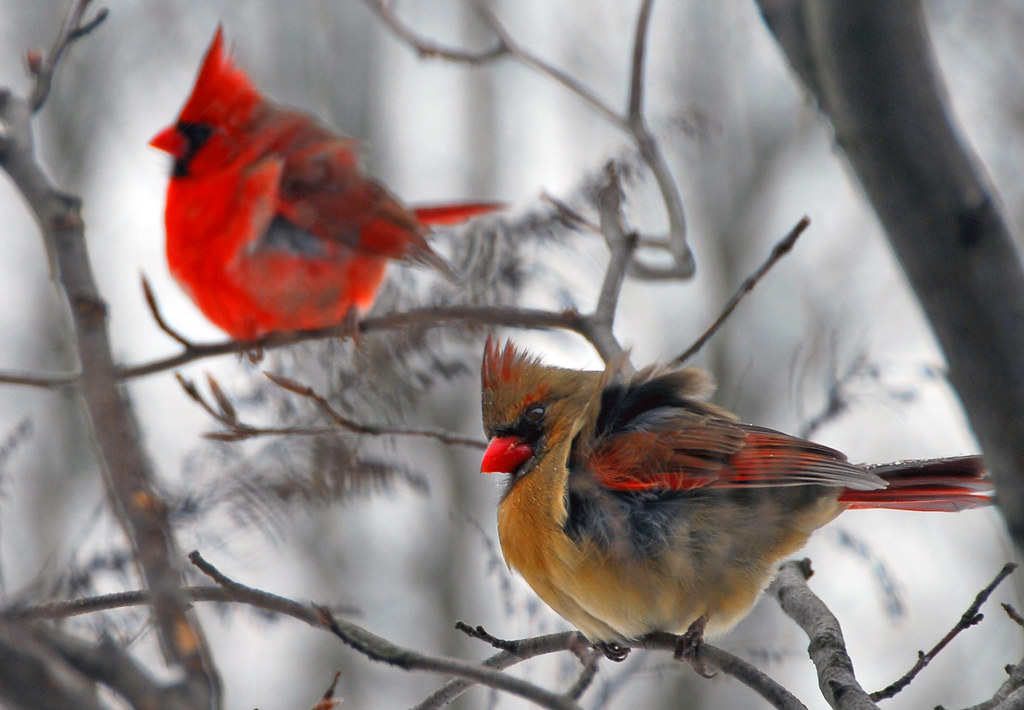SCORES & OUTDOORS: How do our little feathered friends fare during winter
 by Roland D. Hallee
by Roland D. Hallee
Last week we took a look at how white-tailed deer keep warm during those cold winter days and nights. As you remember, that was perpetrated by my watching birds at my wife’s feeders during the recent blizzard in early February. So, let’s talk about how those little feathered friends keep warm during those times.
First of all, I was astonished as I watched the birds come in and out of the feeders during the height of the storm, with winds gusting to 25-30 miles per hour.
Birds are warm-blooded animals that have a much higher temperature than humans, usually in the range of 105 degrees, as compared to our 98.6 degrees. Body temperatures can vary during daylight hours but it can challenge the birds during the night to maintain such a high body heat.
Smaller birds run more of a risk of body heat loss since they have a proportionately larger surface area on their bodies to lose heat but a smaller core volume to generate it.
Birds have different ways to maintain body heat during cold weather. Their feathers provide remarkable insulation, and many species will actually grow extra feathers as part of a late fall molt to give them thicker protection in the winter. Oil also coats their feathers to provide, not only insulation, but waterproofing.
Their legs and feet are covered with scales to minimize heat loss. By constricting blood flow to their extreminities, they can also reduce body heat loss even further.
Then, there is the old standby: adding body fat reserves to serve as insulation and extra energy for generating body heat. They will gorge themselves in the fall when food sources are abundant.
Another way to produce insulation from the cold is to fluff their feathers. That enables air pockets to be created, keeping them toasty warm. Also, it is not unusual to see birds standing on one leg or crouched to cover both legs with their feathers to shield them from the cold. They also tuck their beaks into their shoulder feathers for protection, and to breathe air warmed from their body heat.
On sunny days, they will perch with their backs to the sun to maximize the exposure area of their body. They raise their wings to allow the skin and feathers to absorb as much of the sun’s heat as possible, even spreading or drooping their wings while sunning.
If you see a bird shivering, don’t worry. They do this to raise their metabolic rate and generate more body heat as a short term solution in extreme cold.
Many small birds will gather in large flocks at night and crowd together in an attempt to share their collective body heat. Even individually, they will roost in places that may contain residual heat from the day’s sunlight.
But, there is something called torpor that birds will use to conserve energy during the cold nights. Torpor is a state of reduced metabolism when the body temperature is lowered, therefore requiring fewer calories to maintain the proper heat. Birds can lower their body temperature from 22 to 50 degrees. Torpor, however, can be dangerous as reduced temperature also leads to slower reactions and greater vulnerability to predators.
Even with all of these Mother Nature-built in safeguards, mortality rate among birds can run high during extreme winters. You can help.
During winter, keep your feeders cleared of snow and filled with good food, offer liquid water, and provide shelter. You can build brush piles or protective boxes if you have no natural shelters. I think one of the reasons we have as many birds during winter as we have is because birds are attracted to coniferous trees. My wife and I have three rather large pine trees in our backyard, providing them with plenty of protection from the weather.
Mother Nature, again, provides for its creatures, large or small.
Roland’s trivia question of the week:
Which current NFL team was originally called the New York Titans?
Responsible journalism is hard work!
It is also expensive!
If you enjoy reading The Town Line and the good news we bring you each week, would you consider a donation to help us continue the work we’re doing?
The Town Line is a 501(c)(3) nonprofit private foundation, and all donations are tax deductible under the Internal Revenue Service code.
To help, please visit our online donation page or mail a check payable to The Town Line, PO Box 89, South China, ME 04358. Your contribution is appreciated!



Leave a Reply
Want to join the discussion?Feel free to contribute!